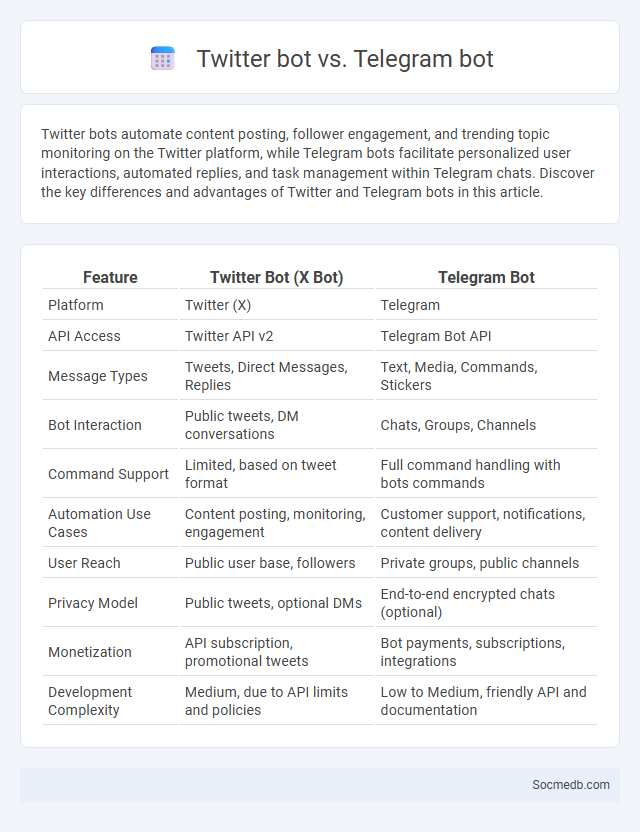
Photo illustration: Twitter Bot vs Telegram Bot
Twitter bots automate content posting, follower engagement, and trending topic monitoring on the Twitter platform, while Telegram bots facilitate personalized user interactions, automated replies, and task management within Telegram chats. Discover the key differences and advantages of Twitter and Telegram bots in this article.
Table of Comparison
| Feature | Twitter Bot (X Bot) | Telegram Bot |
|---|---|---|
| Platform | Twitter (X) | Telegram |
| API Access | Twitter API v2 | Telegram Bot API |
| Message Types | Tweets, Direct Messages, Replies | Text, Media, Commands, Stickers |
| Bot Interaction | Public tweets, DM conversations | Chats, Groups, Channels |
| Command Support | Limited, based on tweet format | Full command handling with bots commands |
| Automation Use Cases | Content posting, monitoring, engagement | Customer support, notifications, content delivery |
| User Reach | Public user base, followers | Private groups, public channels |
| Privacy Model | Public tweets, optional DMs | End-to-end encrypted chats (optional) |
| Monetization | API subscription, promotional tweets | Bot payments, subscriptions, integrations |
| Development Complexity | Medium, due to API limits and policies | Low to Medium, friendly API and documentation |
Introduction to Bots: Definition and Importance
Bots are automated software programs designed to perform specific tasks on social media platforms, such as posting content, responding to messages, or analyzing data. Their importance lies in enhancing efficiency, managing large volumes of interactions, and providing real-time insights. Understanding how bots operate helps you leverage their capabilities to improve engagement and streamline social media management.
Twitter Bots: Features and Use Cases
Twitter bots automate posting, retweeting, and following to enhance engagement and visibility on the platform. Key features include scheduled tweets, keyword monitoring, and sentiment analysis, which help brands optimize content delivery and audience interaction. Use cases range from customer service automation and news dissemination to influencer marketing and trend monitoring, increasing efficiency and reach for businesses and individuals.
Telegram Bots: Capabilities and Applications
Telegram Bots leverage advanced API integrations to automate messaging, manage group activities, and provide real-time information services. These bots support functionalities such as customer support, content distribution, interactive quizzes, and e-commerce transactions, enhancing user engagement on the platform. Utilizing natural language processing and AI, Telegram Bots enable personalized communication and efficient workflow automation across various industries.
General Bots: Overview and Types
General bots on social media automate interactions such as posting, liking, commenting, and message sending, enhancing engagement and content dissemination. Common types include chatbots, which provide customer service; spam bots, designed to spread unwanted content; and influencer bots, which simulate user activity to boost follower counts. Understanding the diverse functionalities and impacts of these bots is crucial for managing social media ecosystems effectively.
Key Differences: Twitter Bot vs Telegram Bot vs General Bot
Twitter bots automate interactions on the Twitter platform, focusing on posting tweets, retweeting, and following users based on real-time trends and hashtags, leveraging Twitter's API for social engagement. Telegram bots operate within Telegram's messaging environment, enabling interactive communication, automated responses, and integration with chat groups or channels through Telegram Bot API, supporting multimedia and sticker use. General bots encompass a broader range of applications across various platforms, often designed with adaptable frameworks for customer service, data processing, or task automation beyond social media-specific functions.
Platform Integration and API Support
Platform integration in social media enables seamless connectivity between various apps, enhancing user experience by allowing data sharing and unified management of content across multiple networks. Robust API support empowers developers to build custom tools and automate interactions, optimizing Your social media management and driving engagement. Leveraging these technologies ensures efficient workflow, increased reach, and improved analytics for targeted marketing strategies.
Security and Privacy Considerations
Protecting your social media accounts requires strong, unique passwords and enabling two-factor authentication to prevent unauthorized access. Regularly reviewing privacy settings ensures your personal information is shared only with intended audiences, minimizing risks of data breaches or identity theft. Being cautious about the content you share and recognizing phishing attempts helps safeguard your digital footprint and maintain your online security.
Development and Deployment Processes
Efficient social media development and deployment processes involve iterative design, rigorous testing, and continuous integration to ensure seamless user experiences. Your platform must integrate APIs and automation tools to streamline content scheduling, monitoring, and real-time analytics. Emphasizing scalable infrastructure and agile methodologies accelerates updates, reduces downtime, and enhances user engagement.
Popular Examples of Each Bot Type
Social media platforms host various types of bots, each serving distinct purposes to influence user experience and engagement. Popular examples include chatbots like Facebook Messenger bots that automate customer service, social bots such as Twitter bots that amplify political messages or trends, and spam bots that flood platforms like Instagram with unsolicited content or fake followers. Understanding how these bots operate can help you recognize authentic interactions and protect your online presence.
Choosing the Right Bot for Your Needs
Selecting the right social media bot requires understanding your specific goals, whether it's increasing engagement, automating content posting, or monitoring analytics. Prioritize bots with features that align with your platform, such as Instagram automation tools like Jarvee or Twitter bots like TweetDeck for scheduling and interaction. Evaluate the bot's compliance with platform policies to avoid penalties and ensure long-term effectiveness.
 socmedb.com
socmedb.com